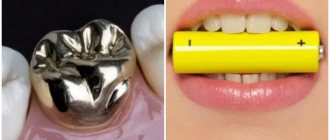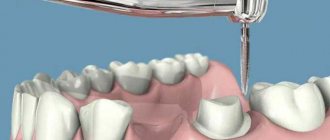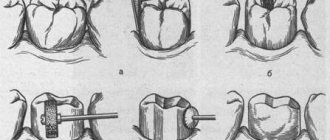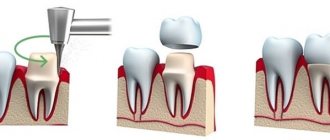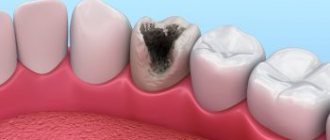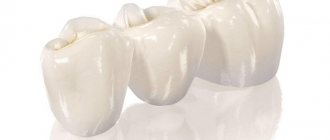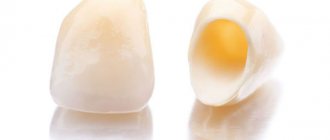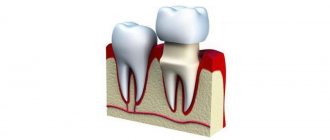Dental crowns in our clinic
Specialists from the Beryozka clinic will help you place strong dental crowns based on an individual impression. Our doctors work according to the most modern treatment protocols, which ensures maximum similarity of the artificial crown with the real one. High-tech materials ensure long-lasting wear even with intensive use of the crown.
Making a crown based on an individual impression ensures the most comfortable use. And budget prices allow you to restore the beauty and functionality of the jaws to a person with any income.
Free consultation!
You can get acquainted with the specialists of the Beryozka clinic and decide on the need to install a crown at a free consultation. Our doctors are confident that the patient, once in their hands, will definitely return for treatment. This is facilitated by the beautiful and comfortable environment in the offices, friendly and polite staff, as well as the high professionalism of the dentists.
Reviews
Of particular interest is the use of metal-composite crowns, since they are installed much less frequently than metal-ceramic and metal-plastic crowns.
If you have experience using crowns lined with composite, tell us what their features are, how many years did they last, and what condition were they in? The comment form is at the bottom of this page.
If you find an error, please select a piece of text and press Ctrl+Enter.
Tags dental crowns fixed dentures
Did you like the article? stay tuned
No comments yet
What is a dental crown
The visible part of a natural tooth is the crown. It is most often destroyed due to caries, trauma or the process of demineralization. It can be restored with an artificial prosthesis - a dental crown. It can be temporary - for the period of treatment, or permanent - for every day. In some cases, crowns are used to correct the shape of implants when they are damaged.
Contraindications
Like any medical procedure, the installation of crowns has contraindications. Cases in which the procedure is not performed:
- advanced periodontitis;
- bruxism - teeth grinding;
- fragile enamel;
- teeth are small and poorly positioned;
- pathological bite, when the incisors overlap one another.
Sometimes the age of the patient may be a contraindication to installing a crown made of a certain material. Then he is offered another way to restore the integrity of the dentition.
What are they: materials
Crowns are made from different materials: some are more durable, others are only suitable as a temporary measure. Their cost, complexity of manufacturing and installation also depend on this.
Metal ceramics
The product has a metal frame and is covered with ceramics on top.
| Pros: | Minuses: |
| High strength. | Contraindicated for people under 18 years of age. |
| Aesthetics. | Not suitable for gum recession. |
Metal-ceramic crowns are suitable for installation only in adult patients.
Metal composite
The crown frame is made of an alloy of chromium and cobalt. From above it is covered with a photopolymer composite: while it is soft, it is given a shape, after which it is fixed with UV rays.
| Pros: | Minuses: |
| High strength. | Coloring from products with pigment. |
| Thin and invisible edges. |
People with metal-composite crowns need to follow a diet to prevent artificial teeth from changing color. It is not recommended to consume drinks with dyes and foods with a high pigment content.
Golden
The oldest material for making crowns is gold.
| Pros: | Minuses: |
| Hypoallergenic. | Lack of aesthetics. |
| They do not damage neighboring healthy teeth. | Rapid abrasion due to the softness of the metal. |
It is best to install gold crowns on the back teeth, where they will be almost invisible.
Zirconium dioxide
Modern material for crowns is zirconium dioxide. It is durable, aesthetic, does not cause allergies and lasts a long time. But it has a fairly high cost, so it’s not suitable for everyone’s budget.
Metal-free
Modern synthetic materials can completely replace metal in the composition of the crown. They are no less durable, and look as close as possible to natural teeth.
Ceramic
The best way to choose the color of a crown is when it is made of ceramic. They do not look artificial, as they are quite transparent.
They are great for replacing incisors. But for chewing teeth, ceramic crowns are too fragile and cannot withstand such a load.
Porcelain
Porcelain crowns are not so popular, but are gradually becoming more and more in demand. They are easily and firmly fixed, which reduces the risk of loosening. Porcelain products last a long time, do not deteriorate due to temperature changes and are not stained by food. In this case, the crown can be made in an anatomical shape, repeating the relief of the tooth as accurately as possible, which ensures comfortable wearing. They look very aesthetically pleasing and are also hypoallergenic.
One of the disadvantages is their loose fit to the tooth, which can cause cervical caries. Crowns are quite fragile and can destroy adjacent healthy teeth. The product is not suitable for patients with thin enamel. In addition, the cost of such crowns is quite high, which is not affordable for everyone.
Combined
By combining several materials, it is possible to create crowns that combine their best properties. The product is suitable for use on front and back teeth: they look aesthetically pleasing and can withstand chewing loads. But such crowns are short-lived because they quickly wear out and sometimes become deformed. But their installation does not cause a blow to the budget.
Plastic
Plastic crowns are used as a temporary measure. They are manufactured on site and installed on the same day in place of the extracted or treated tooth. The cost of such crowns is low. But it is impossible to use them as permanent ones, since they cannot withstand prolonged chewing load.
Price issue
The cost is determined mainly by the cladding material (not counting products made of precious metals). Depending on it, the price of microprosthetics can range from several to 2 tens of thousand rubles.
The table shows approximate prices for lined structures. But you need to understand that if you want, you can always find an option a couple of thousand cheaper than the market average.
| Type of crown | Cost, rub. | Features of the instructions |
| Metal-plastic | From 2 500 | Frame made of dental socket (stainless steel) |
| Metal composite | From 7 000 | Material GC Gradia or TwiNY |
| Metal-ceramic | From 8 000 | Nickel-chrome alloy frame |
| Metal-ceramic | From 18 000 | Gold frame |
Types of crowns
The number of missing teeth, the presence of dentures and other individual characteristics of the patient determine what type of crown is suitable for him. It is impossible to determine this in absentia, since it requires an examination by a specialist.
Bridges
Suitable for people who have lost more than one tooth. The prosthesis is made for all missing units, and its parts are connected by a metal bridge. To secure the crowns, you need healthy chewing teeth. Only complex prosthetics are performed in this way.
Implant supported crowns
If the patient has implants, the crown can be secured to them. This will prevent the destruction of healthy teeth, which can occur due to excess stress. But the method is only suitable for those who already have implants installed.
Crown for one tooth
If one tooth is destroyed, a crown can be installed only on it. This usually happens after deep caries or injuries. Before installing a crown, the condition of the periodontium, jaw and gum tissue is assessed. Sometimes additional operations are performed to build up the bone plate.
Fixation with a pin
The rarest method of prosthetics is installing a crown on a pin. It is quite traumatic and carries a risk of complications, so it is almost never used. If other methods of prosthetics are not available to the patient, the crown is installed on a pin, but this is done in several stages under the supervision of specialists at each of them.
Kinds
A solid metal crown can be made from different materials.
Such products can be:
- metal with spraying,
- without spraying,
- with lining,
- combined bridge prosthesis.
The design without coating does not look very aesthetically pleasing; it is made of polished metal. It has a relatively low price, but not everyone is happy with it.
If aesthetics are important to the patient, then you should choose a crown with a coating that imitates gold. They look more attractive, but you should be careful when spraying: it can have a negative effect on the mucous membrane.
A one-piece crown with ceramic lining is perhaps the most aesthetic option of the three already presented - it has an overlay made of ceramic or plastic, which is located on its front surface. Of course, the pad also needs to be treated with care, because it is made of fragile materials, but if you follow the rules of care, it will last a long time.
A combined prosthesis is created from several metal-ceramic crowns that cover the smile area, and from solid polished crowns.
Methods for making a crown
Orthodontic products can be manufactured using several methods. Each of them has its own advantages and disadvantages.
Cast products
Strong and durable crowns are made using casting. For this, a single piece of metal is used. The method is not suitable for all materials.
Stamped
More affordable, but less durable prostheses are made by stamping:
- a mold is placed into the dental anvil;
- using rubber rings a stamp is obtained;
- the crown is made using special hammers that differ in shape and size;
- The product is given its final shape using small tongs.
Such crowns last less than cast ones, but are much cheaper to produce.
How a tooth crown is made
Before starting to make the prosthesis, the size and shape of the product are determined. To do this, the patient undergoes:
- examination by a doctor;
- general and targeted x-ray diagnostics;
- 3D - visualization on a computer screen of the entire jaw and a specific tooth.
Then the doctor selects the material from which the crown will be made. It depends on which tooth needs to be replaced, the age of the patient and his financial capabilities.
To accurately manufacture the prosthesis, an impression of the jaw is taken. For this, gypsum or a similar synthetic material is used. The resulting model is sent to the laboratory.
Life time
The service life of combined crowns depends to a greater extent on the lining material and, to a lesser extent, on the technology of its application and the installation location.
- For reference. Metal-free structures made of zirconium dioxide last the longest - up to 15-20 years.
- In second place are metal-ceramic structures - 10-15 years.
- The service life of metal composite products largely depends on the properties of the composite and can vary from 5 to 10 years.
- Metal-plastic crowns have the shortest service life, limited to 5 years.
The service life of combined microprostheses is affected by their care and the patient’s dietary preferences. Recommendations regarding the use of combined crowns are practically no different from those given for any type of prosthetics.
You need to brush your teeth at least 2 times a day, give up solid foods and smoking, regularly visit the dentist for preventive purposes, and, if necessary, resort to professional cleaning.
Preparing for installation
A crown cannot be placed on an unprepared tooth. He must be completely healthy. If you have inflammatory diseases of the oral cavity, they need to be cured before installing a crown.
Then the teeth are ground down. It is performed under anesthesia, so the patient does not experience any discomfort. This procedure is carried out to ensure that the denture fits perfectly and no food remains get stuck under it. It also allows you to equalize the width of the neck and middle of the tooth. This way the prosthesis will be firmly fixed, which will prevent loosening.
Only 1-2 mm of enamel is removed. The depth of treatment depends on the selected crown material: metal-ceramics require more space, and ceramics are quite thin; a very thin layer is removed to install it.
In some cases, depulpation is performed. The patient is warned about its need in advance.
If the tooth is severely damaged, a core inlay is installed. It separates the internal tissues from the crown, allowing you to avoid pain while wearing it.
Upon completion of all manipulations, a temporary crown is installed on the tooth. It is made in the dentist's chair. The design protects the prepared area and restores its aesthetic appearance.
Installation process
The crown is installed in several stages. The number of visits to the doctor depends on the condition of the teeth and the chosen prosthetic method.
Laboratory stage
A cast of the patient's jaw is sent to the laboratory to create a plaster model of the jaw. After complete drying, the desired part is cut out. Using it, a wax prototype is made.
The model is fixed on the base and filled with a special mixture. It goes into the oven for 4-5 hours. The resulting mold is immediately filled with the alloy while it is hot. The future crown is left in this form until it hardens completely. The piece is then polished and sanded to achieve the perfect shape.
Removing the temporary structure
When the permanent crown is ready, the temporary structure is removed. It only takes a few minutes, after which prosthetics can be applied.
Installing a crown on a tooth
Before fixing the crown, a fitting is performed. If it is uncomfortable or the enamel color is not suitable, it is sent for revision. When the crown is perfect, it is secured with cement. The strength of the fixation must be checked after the material has hardened.
Monitoring the situation after installation
After fixing the crown, the doctor checks how correctly it is installed. To do this, an x-ray is taken. Only after his assessment can the patient go home. If you experience strange sensations, you should call your dentist to clarify your condition and the need for a second visit.
Our advantages
At the Beryozka clinic, the material for the crown and its type are selected individually. Each patient is given an approximate treatment estimate so that he can clearly see what he is paying for. A transparent work system, professionals, the latest equipment and materials ensure the ideal result of prosthetics at the Beryozka clinic. A polite attitude and the ability to quickly get an appointment are the key to pleasant emotions from visiting a dentist.
Veneers
A special type of crown can be considered veneers - veneers that cover the outer surface of the teeth of the anterior group and restore their shape and color. This design is distinguished by gentle preparation (within the enamel) or its absence at all (lumineers) and use in the so-called. aesthetic zone - the area of the dental arch visible when talking and smiling. The thickness depends on the material, manufacturing technology and clinical situation, varying from 0.3 to 1 mm.
Veneers
Depending on the technology, a distinction is made between semi-direct veneers and indirect veneers. Both varieties are made on a model in the laboratory (in the first case, from a clinical composite (which is used for “fillings”), in the second, from laboratory material). Temporary veneers are made of plastic and are used to protect prepared teeth and provide aesthetic correction while permanent ones are being made.
Indications for use:
- Changes in tooth color (discoloration);
- Tooth surface defects – stained cracks, non-carious lesions extending beyond the middle of the vestibular surface;
- Gaps between teeth (diastema, tremata) – if you do not want orthodontic correction or as a relapse of treatment;
- Dental trauma (crown angle fracture);
- Abrasion along the cutting edge.
Contraindications for use:
- Inability to preserve more than half of the enamel during preparation or severe damage to the crown;
- Teeth with removed pulp;
- Parafunctions of the masticatory muscles – non-functional contractions (grinding, clenching);
- Pathological types of bite;
- Carious lesions and/or fillings/restorations;
- Temporary teeth;
- Poor oral hygiene;
- Hereditary inferiority of the enamel structure;
- Acute or exacerbation of chronic diseases of the oral cavity, accompanied by the formation and release of inflammatory fluid (temporary).
Manufacturing methods:
- Injection pressing followed by sintering of ceramic mass (Dicor, IPS Empress);
- Vacuum firing on a refractory model (refractor);
- Milling on a computer-controlled machine from ready-made factory blocks - CAD/CAM (computer aided design and manufacturing) - Cerec, Everest Procera, Cercon systems and In-Ceram, Vollceram, Hi-Ceram masses.
Being a type of crown , a veneer has almost identical advantages and clinical and laboratory manufacturing stages. Due to the special aesthetic value of the anterior part of the dentition, it is advisable to follow a photo protocol, which involves capturing the image of the patient’s face in front and profile, a smile, the nature of the closure of the dentition in the anterior part, and each of them separately against a contrasting background. This information is useful for the clinician and especially the technician for the purpose of planning this type of construction.
Caries , increased abrasion or trauma often lead to almost complete destruction of the crown of the tooth while preserving its root or roots. Restoration of a tooth crown in its absence is carried out using artificial crowns on cast stump pin inlays - LKSHV. This design consists of a pin cemented in the prepared part of the root canal and an artificial stump. They are cast in a single solid from gold, silver-palladium or cobalt-chrome alloy.
Root requirements for prosthetics:
- Good channel permeability throughout its entire length;
- Hermetic filling of the apical part and absence of pathological changes around the root;
- Sufficient length (twice as long as the crown);
- Sufficient wall thickness to withstand chewing pressure and their hardness;
- Root resistance;
- The presence of a supragingival part of at least 2 mm.
Design advantages:
- The ability to replace an artificial crown without the need to remove the pin (this compares favorably with previously used pinned teeth, in which the artificial crown and stump were one whole);
- The ability to use a stump to support a bridge when removing an adjacent tooth;
- Possibility of prosthetic bridge prosthesis for defects limited by the roots (if the channels and pins are not parallel, it is possible to apply a prosthesis due to the parallelism of the walls of the stumps).
After creating an artificial stump with a pin and fixing it in the root canal in the usual way, the whole complex of measures and manipulations is carried out in accordance with prosthetics with artificial crowns .
Pros and cons of crowns
All medical procedures have both pros and cons. Before you decide to install crowns, you should compare the pros and cons.
Advantages
The advantages of using this method of prosthetics are much greater than the disadvantages. The advantages of installing crowns include:
- preventing the destruction of pulpless teeth;
- preservation of a living tooth even with partial destruction;
- restoration of the ability to chew food normally;
- restoration of an aesthetic appearance while smiling;
- prevention of diseases of the gastrointestinal tract, which can be caused by insufficient chewing of food;
- restoration of the ability to speak clearly.
Due to the large number of advantages, the procedure has become so popular among patients.
Flaws
The procedure for installing crowns has its disadvantages. Flaws:
- the need to grind healthy parts of the tooth;
- limited period of wearing a prosthesis;
- inability to carry out the procedure with a damaged root;
- the need for regular visits to the dentist for monitoring.
The disadvantages of the procedure are offset by its advantages. Therefore, crowns remain the most popular way to restore the integrity of the dentition.


